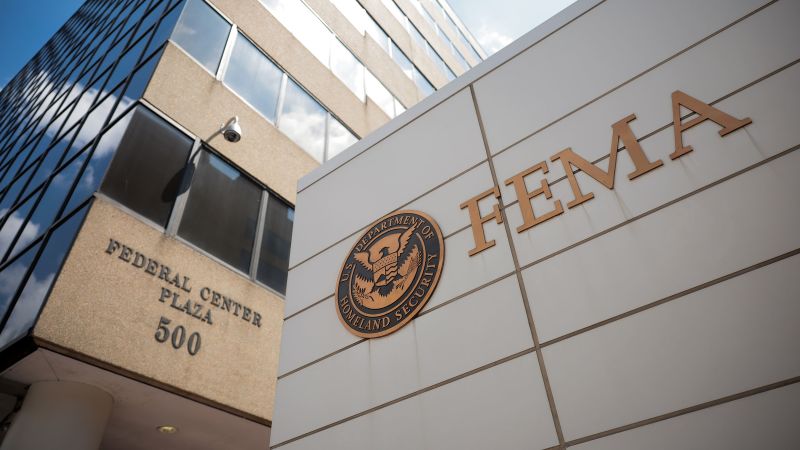The Department of Homeland Security (DHS) has taken a significant step by appointing a number of its officials into crucial front office roles at the Federal Emergency Management Agency (FEMA). This move, driven by multiple sources and confirmed through an internal memo obtained by CNN, showcases an intentional overhaul of FEMA aimed at restructuring its operations during a critical time.
As hurricane season approaches—less than two weeks away—the timing of this major shakeup raises concerns among disaster management experts and officials alike. The officials from the DHS are stepping in to replace several veteran leaders of FEMA. This shift signifies a pivotal moment in the Trump administration’s reorganization of the disaster relief agency, highlighting a broader strategy to control the agency’s direction.
In a memo released on a Wednesday, FEMA’s leadership outlined a comprehensive reorganization. This restructuring comes amid feelings of confusion and disarray, primarily due to a shrinking workforce within the agency. There has been a pronounced sentiment among high-ranking officials in the Trump administration about the desire to eventually dismantle FEMA entirely.
The newly assigned officials are set to play critical advisory roles under the leadership of acting FEMA Administrator David Richardson, who also hails from DHS. However, evidence suggests that many of these individuals have limited experience in handling natural disasters, as indicated by their backgrounds included in the announcement. Similar to Richardson, most have previously worked in the DHS’s Countering Weapons of Mass Destruction office, with some splitting their time between this and their new responsibilities at FEMA.
Critically, it has come to light that only two of Richardson’s seven advisors currently hold positions within FEMA, and neither have previously served in high-ranking roles. Few, if any, individuals in the revised front office held their new positions prior to Donald Trump taking office. While changes in leadership are typical with new administrations, such a major overhaul just ahead of hurricane season—when emergency preparedness is paramount—has raised eyebrows.
A concerned FEMA official has expressed that “the key takeaway is that the front office operation for the nation’s disaster management agency has zero people with actual disaster response and recovery experience,” alarmingly close to the start of the hurricane season. Many officials are increasingly worried that FEMA will not be adequately equipped to handle the inevitable natural catastrophes that will arise in the upcoming months. An internal assessment, acquired by CNN, openly acknowledged that FEMA “is not ready” for the hurricane season.
This extensive announcement also highlighted a wave of departures, with 16 senior executives leaving the agency, including seasoned leadership from essential divisions such as Response and Recovery and Professional Responsibility. Among those resigning was MaryAnn Tierney, FEMA’s second-in-command, who cited a sense of duty towards assisting fellow Americans during crises as a primary motivator for her work.
In conjunction, the agency is facing significant staffing challenges, with around 10% of its workforce leaving since January, and projections indicate that nearly 30% of staff could be lost by year’s end. Acting Administrator Richardson informed the agency of anticipated further staffing drops, which poses considerable challenges in readiness.
Through these developments, skepticism remains regarding the administration’s objectives. Questions arise about whether the intention is genuinely to maintain competent leadership during a turbulent period, or merely a message emphasizing FEMA’s role within DHS while dismissing existing frameworks.
Furthermore, FEMA’s spokesperson disclosed the agency’s shift towards empowering state governments in their disaster management efforts. With Secretary Kristi Noem leading DHS, there has been an increased emphasis on prioritizing state capabilities over federal oversight. Richardson, a former Marine combat veteran, has made it clear that his commitment is to uphold President Trump’s agenda without compromise, hoping to redefine FEMA’s operations.
Richardson’s efforts included rescinding the agency’s strategic plan set for 2022-2026, which he deemed irrelevant for achieving FEMA’s objectives. Instead, this leadership intends to develop a new strategy for 2026-2030 later this summer, amid concerns regarding immediate preparedness.
To fortify these initiatives, President Trump has established a FEMA review council, signaling a commitment to reassess the agency’s structure and purpose. During its initial meeting, Noem reiterated a need for drastic changes, even contemplating renaming the agency entirely. Her vision emphasizes minimizing federal intervention in emergency management, advocating for states to take the lead in disaster situations, bolstered by federal support during financial crises.
In summation, as FEMA transitions into this unprecedented chapter under new management, the impending hurricane season adds urgency to these changes. The implications of leadership with limited disaster response experience, staffing cuts, and the overarching goal of redefining emergency management roles raise critical questions about the agency’s ability to respond effectively to future disasters.



